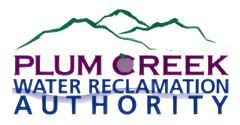News and Information
The Latest News and Information at PCWRA
PCWRA's Biological Nutrient Removal
Beginning in 2001, PCWRA staff and Board members embarked on the funding and construction of a new Biological Nutrient Removal (BNR) plant. This project took PCWRA from a 3.55 MGD conventional activated sludge treatment plant to a 4.87 MGD BNR plant. Culminating in early 2005, the plant began functioning with additional screw pumps, a new grit removal system, two oxidation ditches, two clarifiers, filtration, UV disinfection and improved Biosolids handling. A third ditch and clarifier were built but not fully equipped at this time, taking advantage of civil site work while delaying expenditures for equipment not yet needed, although they provide future capacity for population growth. Upon startup, an extended performance test demonstrated this new plant would be able to handle a larger hydraulic flow than originally thought. In 2009, after submitting a new Utility Plan, the CDPHE increased the rated plant capacity to 6.44 MGD. New Standards could create the need for another expansion and/or updated processes. A new permit for the increased rate capacity of 6.44 MGD became effective in November of 2012.
Name Change!
Plum Creek Wastewater Authority is now Plum Creek Water Reclamation Authority.
The decision to change the facility's name was driven by the desire to better describe the Authority with our current activities.
Definition:
Water reclamation is a process by which wastewater from homes and businesses is cleaned using biological and chemical treatment so that the water can be returned to the environment safely to augment the natural systems from which it came. It is used today as both an aquifer and stream enhancement strategy.
Benefits:
Water reclamation helps decrease diverging water from sensitive eco-systems which depend greatly on the flow to improve the quality of the water. Water reclamation also decreases the pollution to bodies of water, such as oceans and rivers, by diverting the wastewater. Some of the pollutants are used for irrigation purposes, such as nitrogen, which would be harmful to these bodies of water. Another benefit is the enhancement of wetlands which benefits the wildlife dependent on that eco-system.
Uses:
Most of the uses of water reclamation are nonpotable uses such as Washing Cars, flushing toilets, cooling water for power plants, concrete mixing, artificial lakes, and irrigation for golf courses and public parks. Most systems run a dual piping system to keep the recycled water separate from the potable water.
New Discharge Permit Issued to PCWRA
PCWRA was issued a new National Pollutant Discharge Elimination System (NPDES) permit which began on November 1, 2012.
Background on the NPDES permit system:
The Clean Water Act of 1972 act introduced the National Pollutant Discharge Elimination System (NPDES), which is a permit system for regulating point sources of pollution. Point sources include:
- industrial facilities (including manufacturing, mining, oil and gas extraction, and service industries)
- municipal governments and other government facilities (such as military bases), and
- some agricultural facilities, such as animal feedlots.
Point sources may not discharge pollutants to surface waters without a permit from the National Pollutant Discharge Elimination System (NPDES). This system is managed by the United States Environmental Protection Agency (EPA) in partnership with state environmental agencies. EPA has authorized 46 states to issue permits directly to the discharging facilities. For additional information on NPDES click Here.
TENORM
Technologically Enhanced Naturally Occurring Radioactive Material (TENORM) can be produced during normal drinking water treatment. There are many radioactive elements in nature, including uranium, thorium, and radium. These elements may dissolve into groundwater from the surrounding bedrock. The EPA has set a maximum contaminant limit (MCL) of 5pCi/g of radium in drinking water. However, even if the untreated source water is below the MCL, radium can be further reduced with the removal of iron from the water. While this is good for drinking water quality, the material that is removed from the water may create an expensive disposal problem for the water treatment facility. Some water facilities separate this material and have it trucked to an approved disposal site or landfill. Other water facilities discharge this material into the sanitary sewer. While discharging to the sewer effectively dilutes the TENORM, it passes through the wastewater treatment process, and may still create a disposal problem for the biosolids produced at the wastewater utility.
Colorado has regulations that specify how TENORM must be handled, and the CPDHE is currently investigating the issue of water treatment plant residuals.
